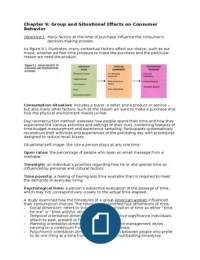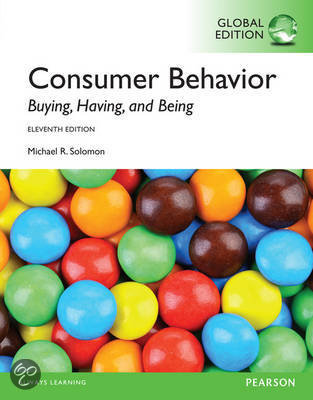Chapter 9: Group and Situational Effects on Consumer
Behavior
Objective 1 Many factors at the time of purchase influence the consumer’s
decision-making process.
As figure 9.1 illustrates, many contextual factors affect our choice, such as our
mood, whether we feel time pressure to make the purchase and the particular
reason we need the product.
Consumption situation: includes a buyer, a seller and a product or service –
but also many other factors, such as the reason we want to make a purchase and
how the physical environment makes us feel.
Day reconstruction method: assesses how people spend their time and how they
experience the various activities and settings of their lives, combining features of
time-budget measurement and experience sampling. Participants systematically
reconstruct their activities and experiences of the preceding day with procedures
designed to reduce recall biases.
Situational self-image: the role a person plays at any one time.
Open rates: the percentage of people who open an email message from a
marketer.
Timestyle: an individual’s priorities regarding how he or she spends time as
influenced by personal and cultural factors.
Time poverty: a feeling of having less time available than is required to meet
the demands of everyday living.
Psychological time: a person’s subjective evaluation of the passage of time,
which may not correspond very closely to the actual time elapsed.
A study examined how the timestyles of a group American women influenced
their consumption choices. The researchers identified four dimensions of time:
- Social dimension: refers to individuals’ categorization of time as either “time
for me” or “time with/for others”.
- Temporal orientation dimension: depicts the relative significance individuals
attach to past, present or future.
- Planning orientation dimension: alludes to different management styles
varying on a continuum from analytic to spontaneous.
- Polychromic orientation dimension: distinguishes between people who prefer
to do one thing at a time from those who have multitasking timestyles.
,Out of the same study the researchers identified a set of five metaphors that they
say capture the participants’ perspective on time:
- Time is a pressure cooker: these women are usually analytical in their
planning, other-oriented and monochronic in their timestyles. They treat
shopping in a methodical manner and they often feel under pressure and in
conflict.
- Time is a map: these women are usually analytical planners; they exhibit a
future temporal orientation and a polychronic timestyle. They often engage in
extensive-information search and comparison-shop.
- Time is a mirror: women in this group are also analytical planners and have
a polychronic orientation. However, they have a past temporal orientation.
Because of their risk averseness in time use, these women are usually loyal to
products and services they know and trust. They prefer convenience-oriented
products.
- Time is a river: these women are usually spontaneous in their planning
orientation and have a present focus. They go on unplanned, short and
frequent shopping trips.
- Time is a feast: these women are analytical planners with a present
temporal orientation. They view time as something they consume to pursue
sensory pleasure and gratification and for this reason they value hedonic
consumption and variety-seeking.
Co-consumers: other patrons in a consumer setting.
Queuing theory: the mathematical study of waiting lines.
Objective 2 The information a store’s layout, Web site or salespeople provides
strongly influences a purchase decision.
As figure 9.2 indicates, different combinations of pleasure and arousal levels
result in a variety of emotional states:
- Pleasure: a state or feeling of being pleased or gratified.
- Arousal: a state of heightened physiological activity.
Shopping orientation: a consumer’s general attitudes and motivations
regarding the act of shopping. Hedonic shopping motives include the following:
, - Social experiences: the shopping center or department store replaces the
traditional town square or country fair as a community gathering place.
- Sharing of common interests: stores frequently offer specialized good that
allow people with shared interests to communicate.
- Interpersonal attraction: shopping centers are a natural place to
congregate. The shopping mall is a favorite “hangout” for teenagers. It also
represents a controlled, secure environment for the elderly and many malls
now feature “mall walkers’ clubs” for early morning workouts.
- Instant status: as every salesperson knows, some people savor the
experience of being waited on, even though they may not necessarily buy
anything.
- The thrill of the hunt: some people pride themselves on their knowledge of
the marketplace. They may love to haggle and bargain, and even view this
process as a sport.
Showrooming: the process lamented by traditional retailers whereby consumers
shop their stores to obtain product information and then purchase the chosen
product online at a lower price.
Pretailer: an e-commerce site that provides exclusive styles by prodding
manufacturers to produce runway pieces they wouldn’t otherwise make to sell in
stores.
Retail theming: a strategy whereby stores create imaginative environments
that transport shoppers to fantasy worlds or provide other kinds of stimulation.
Innovative merchants today use four basic kinds of theming techniques:
- Landscape themes: rely on associations with images of nature, Earth, animals
and the physical body. E.g., Bass Pro Shops create a simulated outdoor
environment, including pools stocked with fish.
- Marketscape themes: build on associations with man-made places. E.g., The
Venetian hotel in Las Vegas, which lavishly recreates parts of the real Italian
city.
- Cyberspace themes: build on images of information and communications
technology. E.g., eBay’s retail interface instills a sense of community among
its vendors and traders.
- Mindscape themes: draw on abstract ideas and concepts, introspection and
fantasy, and often possess spiritual overtones. E.g., The Kiva day spa in
downtown Chicago offers health treatments based on a theme of Native
American healing ceremonies and religious practices.
Store image: a store’s “personality”, composed of such attributes as location,
merchandise suitability and the knowledge and congeniality of the sales staff.
Being space: a retail environment that resembles a residential living room
where customers are encouraged to congregate.
Minipreneurs: one-person businesses.
Pop-up stores: temporary locations that allow a company to test new brands
without a huge financial commitment.
Atmospherics: the use of space and physical features in store designs to evoke
certain effects in buyers.






